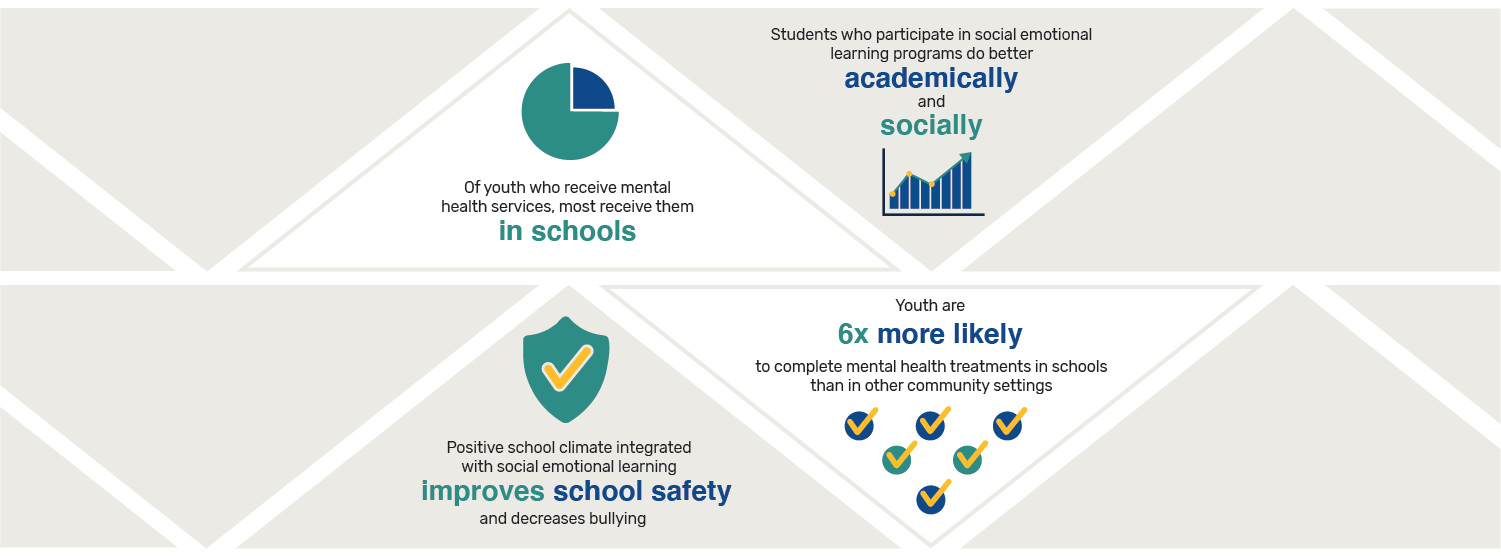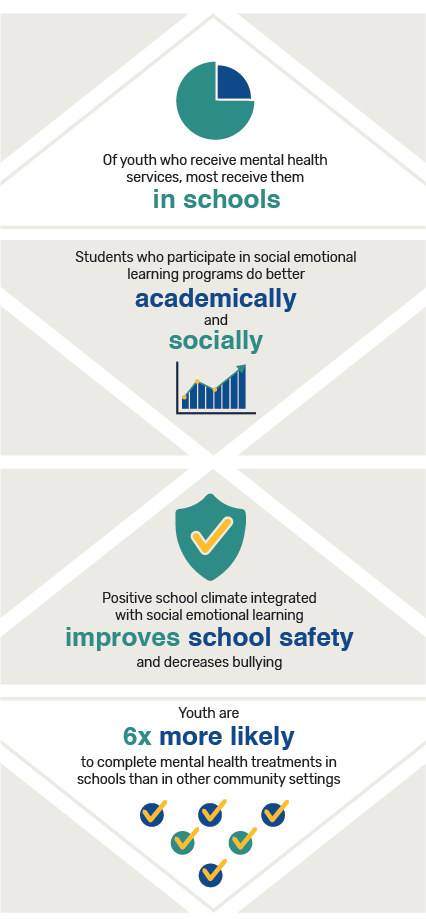-

Now Available!School Mental Health Quality Assessment
– Preschool Version! -

Policy Map The State Policy Map provides an overview
of legislation, regulations, and policies related
to school mental health.View MapSchool Mental Health -
 What is
What isSHAPE? Afree , interactive tool designed to improve accountability,
excellence, and sustainability in school mental health
in schools, districts, and states/territories.Learn More -
 Learn More
Learn More -

SHAPE SpotlightTo engage Education in System of Care implementation,
the New York State Office of Mental Health began assisting
districts in completing the School Mental Health Quality
Assessment on the School Health Assessment and
Performance Evaluation (SHAPE) System.
The SHAPE System Assessment process aligned well
with the System of Care implementation goals of
including family/youth voice and community partners.Learn More
Welcome to SHAPE
From our school mental health quality assessment and resource library, to custom reports and a library of free and low-cost screening and assessment measures, SHAPE has the tools teams need to improve school mental health programming and sustainability in schools, districts, and states/territories. Take the tour to learn more.
Improve student mental health in your schools, districts, states/territories, and entities. Sign up for:
SHAPE helps schools and districts improve
their school mental health systems! HOW?


SHAPE users map their
school mental health
services and supports
Assess system quality
using national
performance standards
Receive custom reports
and strategic planning
guidance and resources
Utilize additional SHAPE features
including the Screening and
Assessment Library and Trauma-
Responsive Schools Assessment
and Resources
Use district and state/territory
dashboards to collaborate
with schools and districts in your region
SHAPE Features
|
Collects information and provides a snapshot of the multi-tiered services and supports, staffing, financing and data systems of your school's or district's comprehensive school mental health system. |
|---|
|
Assesses comprehensive school mental health system quality at the school or district level based on seven quality domains and respective indicators and best practices. Users have access to vetted resources to advance quality. |
|---|
| Provides state/territory leaders the opportunity to systematically view the landscape of school mental health within their districts and districts the opportunity to do the same within their schools. This information may guide state and district technical assistance and quality improvement support efforts. |
|---|
|
Provides information about and links to free assessment measures that can be used within school mental health. The library allows for filtering based on focus area, assessment purpose, student age, language, reporter, and cost. |
|---|
|
Offers district and school teams an evidence-informed tool to assess their trauma responsiveness in eight domains. The TRS-IA was co-developed by the NCTSN Treatment and Services Adaptation Center for Resilience, Hope, and Wellness in Schools and the National Center for School Mental Health (NCSMH). |
|---|
| Collects information and provides a snapshot of the multi-tiered services and supports, staffing, financing and data systems of school and district comprehensive school mental health systems. |
|---|
| Assesses comprehensive school mental health system quality at the school or district level based on seven quality domains and associated indicators and best practices. The comprehensive Resource Library is organized by the seven quality domains. |
|---|
| Provides state/territory leaders the opportunity to view the landscape of school mental health within their districts and district leaders the opportunity to do the same within their schools. This information may guide state and district technical assistance and quality improvement support efforts. |
|---|
| Provides information and links to free assessment measures that can be used within school mental health. Users can filter measures based on focus area, assessment purpose, student age, language, reporter, and cost. |
|---|
| Offers district and school teams an evidence-informed tool to assess trauma responsiveness in eight domains. The Trauma Responsive Schools Implementation Assessment (TRS-IA) was co-developed by the National Child Traumatic Stress Network (NCTSN) Treatment and Services Adaptation Center for Resilience, Hope, and Wellness in Schools and the National Center for School Mental Health (NCSMH). |
|---|
School Mental Health
Matters


The School Mental Health Policy Map displays and links to key state-level policies and information related to school mental health. Decision makers, state and local leaders, and school mental health stakeholders can use this map to better understand the school mental health landscape in their state and across the country. Inclusion of a policy on the map does not indicate endorsement of policies or that a policy is implemented to fidelity.
The NCSMH will regularly update and add to this map. If you see something missing or outdated from your state in one of the categories, please e-mail the NCSMH at [email protected] with the subject line “Map Update.”
To help understand your own state’s school mental health landscape, we encourage state leaders to create a state account on the SHAPE System and complete the State School Mental Health Profile. Information shared will be only shared in aggregate.
The School Mental Health Policy Map displays and links to key policies related to school mental health. Decision makers, state and local leaders, and school mental health stakeholders can use this map to better understand the school mental health policy landscape in their state and across the country. Inclusion of a policy on the map does not indicate endorsement of policies or that a policy is implemented to fidelity. In addition, statewide school mental health staff-to-student ratios are also included on the map when available.
The NCSMH will regularly update and add to this map. If you see something missing or outdated from your state in one of the categories, please e-mail the NCSMH at [email protected] with the subject line “Map Update.”
To help understand your own state’s school mental health landscape, we encourage state leaders to create a state account on the SHAPE System and complete the State School Mental Health Profile. Information shared will be only shared in aggregate.
Exclusionary discipline policies, such as suspensions or expulsions, can have long-term negative consequences on youth (e.g. school dropout and involvement in the juvenile justice system) and school climate (White House Report: The Continuing Need To Rethink Discipline; HHS and U.S. DoE Policy Statement on Exclusionary Discipline). Although federal data demonstrate steady declines in suspensions and expulsions, data indicate that students of color and students with disabilities continue to be disproportionately suspended or expelled.
Several states have addressed the negative consequences and disparities related to exclusionary discipline by enacting policies that direct schools and districts to eliminate or reduce punitive discipline practices and/or implement restorative practices.











































































































Sources: Data retrieved via an extensive independent review by the NCSMH and supplemented by additional sources, including:
National Association of State Boards of Education (NASBE). (2020). State Policy Database: Alternatives to Exclusionary Discipline. Retrieved from: https://statepolicies.nasbe.org/health/categories/social-and-emotional-climate/alternatives-exclusionary-discipline
Education Commission of the States. (2018). School Discipline: Are there non-punitive approaches outlined as alternatives to suspension or expulsion? Retrieved from: http://ecs.force.com/mbdata/MBQuest2RTanw?rep=SD1804
All 50 states and the District of Columbia have either anti-bullying laws, regulations, model policies, or a combination of all three. These require districts to engage in bullying prevention and to respond when bullying occurs. Although it is necessary to address bullying, there is concern regarding the reliance on punitive responses to bullying. Punitive discipline practices do not reduce incidents of bullying and do not address harm.
The links in the map lead to state pages on stopbullying.gov, a site hosted by the US Department of Health and Human Services. In addition to describing the laws, policies, and common components, each state page provides link to the policy itself.











































































































Source: The information in the map was originally collected and compiled by several federal government agencies, including U.S. Department of Education (DoE), Department of Health and Human Services (HHS), and Department of Justice (DOJ).
U.S. Department of Health and Human Services. (2018). Laws, Policies, & Regulations | StopBullying.gov. https://www.stopbullying.gov/resources/laws
One of the most significant components of the Every Student Succeeds Act (ESSA) is the requirement that states include multiple measures in their accountability systems. In addition to academic indicators (academic achievement, academic growth, graduation rate, and progress in achieving English language proficiency (ELP)), states must select at least one indicator of “school quality or student success” such as:
- Rates of chronic absenteeism
- College and career readiness
- Student or educator engagement
- Student access to and completion of advanced coursework
- School climate
States have the flexibility to select multiple “school quality or student success” indicators and to use multiple measures within each indicator.















































































































Source: The information in the map was originally collected and compiled by the Learning Policy Institute.
Learning Policy Institute (2018). Interactive Map: Making ESSA’s equity promise real: State strategies to close the opportunity gap. https://learningpolicyinstitute.org/product/essa-equity-promise-interactive















































































































Source: The information in the map was originally collected and compiled by the Learning Policy Institute.
Learning Policy Institute (2018). Interactive Map: Making ESSA’s equity promise real: State strategies to close the opportunity gap. https://learningpolicyinstitute.org/product/essa-equity-promise-interactive
In 2014, the Center for Medicare and Medicaid Services (CMS) reversed the Free Care Rule, which restricted schools from getting reimbursement for services provided to Medicaid-enrolled students without an Individualized Education Plan (IEP). The reversal permits states to allow school districts to bill Medicaid for school-based health services, including mental health services, provided to all Medicaid-enrolled children, not just those with an IEP. To expand this eligibility, states need to take action, typically through modification of state Medicaid plans. For more information on school Medicaid, please visit the Healthy Students, Promising Futures webpage, a Healthy Schools Campaign program.
The map below displays states that have leveraged the policy reversal by expanding Medicaid coverage in schools, states that are in the process, and states that have not yet taken action.



















































































































Source: This information was originally compiled by the Healthy Schools Campaign through their Healthy Students, Promising Futures program.
Partnering with and effectively engaging families is critical to the success of comprehensive school mental health systems. The map below displays states that have a policy directing districts to develop or implement plans, policies, or programs related to family engagement in schools.
The information in this map was compiled by the National Association of State Boards of Education.











































































































National Association of State Boards of Education (NASBE). (2020). State Policy Database: Family Engagement Plans. Retrieved from: https://statepolicies.nasbe.org/health/categories/family-engagement/family-engagement-plans
Funding for school mental health comes from multiple and diverse funding sources, including federal, state, district, school, and private support. The maps below display states that use federal funding sources (U.S. Department of Education and U.S. Department of Health and Human Services) and those that use state funding sources (e.g. specific appropriations in state budgets, state taxes, and state education funding).
This information was compiled by the Education Commission of the States. Their policy brief, State Funding for Student Mental Health, details these funding sources and includes several state examples.
The School Mental Health Quality Guide: Funding and Sustainability provides background information on funding and sustainability, best practices, examples from the field, and resources.
Source: The information in this map was originally compiled by the Education Commission of the States.
Education Commission of the States. (2021). State funding for student mental health. Retrieved from: https://www.ecs.org/wp-content/uploads/State-Funding-for-Student-Mental-Health.pdf
High school students have rated taking mental health breaks as similar in significance to having access to mental health professionals to youth in high school (Mental Health America, 2020). Advocates, including youth mental health advocates, across the U.S. have taken charge in advocating for bills that expand excused absences to include mental and behavioral health. Several states have passed legislation that allows students to use their allocated excused absences to care for their physical and mental health. The map below provides information on states that have passed mental health excused absences legislation and states with introduced legislation.































































































Source: This information was originally compiled by Mental Health America. Their report, Addressing the Youth Mental Health Crisis: The Urgent Need for More Education, Services, and Supports, describes trends in youth mental health, state legislative initiatives, and recommendations to advance school based mental health.
Mental Health America. (2021). Addressing the youth mental health crisis: The urgent need for more education, services, and supports. Retrieved from: https://mhanational.org/addressing-youth-mental-health-crisis-urgent-need-more-education-services-and-supports
Mental Health America (2020). Young People’s Mental Health In 2020: Hope, Advocacy, and Action for the Future.https://www.mhanational.org/research-reports/young-peoples-mental-health-2020-hope-advocacy-and-action-future
As both prevention of mental health challenges and promotion of mental health wellness, mental health literacy teaches students about mental health conditions, how to develop mental health wellness skills, and engage in help seeking behaviors. The map below provides information on states that have addressed mental health literacy through policies and standards related to curriculum and course requirements.









































































































Source: This information was originally compiled by Mental Health America. Their report, Addressing the Youth Mental Health Crisis: The Urgent Need for More Education, Services, and Supports, describes trends in youth mental health, state legislative initiatives, and recommendations to advance school based mental health.
Mental Health America. (2021). Addressing the youth mental health crisis: The urgent need for more education, services, and supports. Retrieved from: https://mhanational.org/addressing-youth-mental-health-crisis-urgent-need-more-education-services-and-supports
School mental health screening is defined as the use of a systematic tool or process to identify the strengths and needs of students. Screening is conducted for all students, not just students identified as being at risk for or already displaying mental health concerns. This might involve screening an entire population, such as a school’s student body, or a smaller subset of a population, such as a specific grade level. Screening can be accomplished with a systematic tool or process, including standardized student-report, parent-report, teacher-report measures, examining deidentified, aggregate mental health surveillance data, or a structured teacher nomination process. While many districts and schools across the country have implemented mental health screening, few states have developed policy to support this work.
The map below displays states that have passed screening legislation.























































































































Source: Hopeful Futures Campaign (2022). State Legislative Guide for School Mental Health. https://hopefulfutures.us/wp-content/uploads/2022/09/State-Legislative-Guide-for-School-Mental-Health-1.pdf
Public schools nationwide face a critical shortage of mental health staff (i.e., counselors, school psychologists, and school social workers). The map below displays school mental health professional-to-student ratio. The ratios for school social workers and school psychologists are the most recent data (2015-16 academic year) collected by the U.S. Department of Education Civil Rights Data Collection (CRDC). The ratios for school counselors are based on 2018-19 data originally collected by the U.S. Department of Education, National Center for Education Statistics.
Using the CRDC data, the American Civil Liberties Union (ACLU) developed Cops and No Counselors, a report that highlights shortages of mental health staff and the racial disparities in access to supports and resources.
The nationally recommended ratios of mental health professionals are:
School Counselors: 1:250
School Social Workers: 1:250
School Psychologists: 1:500
Source: U.S. Department of Education’s National Center for Education Statistics Common Core of Data. (2020). State Non-fiscal Public Elementary/Secondary Education Survey 2018-19 v.1a. Retrieved from: https://nces.ed.gov/ccd/files.asp
The map below contains links to suicide prevention policy, including training, prevention, intervention, postvention, and other unique statutes which address suicide prevention. American Foundation for Suicide Prevention (AFSP) provides training resources and model legislation for suicide prevention in schools on page 10 of their issue brief, State Laws on Suicide Prevention in Schools (K-12).
If you are thinking about suicide, are worried about a friend or loved one, or would like emotional support, free and confidential help is available through the National Suicide Prevention Lifeline by calling 1-800-273-8255 or via online chat.











































































































Data retrieved via an extensive independent review the NCSMH and supplemented by additional sources, including:
Source: American Foundation for Suicide Prevention (AFSP). (2020). AFSP: State Laws on Suicide Prevention in Schools (K-12). Retrieved from: https://www.datocms-assets.com/12810/1592504862-k-12-schools-issue-brief-6-18-20.pdf
One of every four children attending school has been exposed to a traumatic event that could affect their learning and/or behavior (NCTSN Child Trauma Toolkit for Educators). Trauma and Adverse Childhood Experiences (ACEs) have long-term impacts on educational outcomes and healthy development. Training related to trauma and adverse experiences is one of several components required for building and maintaining a trauma-responsive school. While many states incorporate trauma into their professional development, it is critical that states also provide comprehensive guidance and support that establishes trauma-responsive schools. This includes access to targeted interventions, classroom-based strategies, whole school prevention and safety programming, and the identification and development of in-school, in-family, and community-wide supports. State policies and guidance for schools regarding trauma-informed professional development for teachers included in this map is originally from the NASBE State Policy Database on School Health.











































































































Exclusionary discipline policies, such as suspensions or expulsions, can have long-term negative consequences on youth (e.g. school dropout and involvement in the juvenile justice system) and school climate (White House Report: The Continuing Need To Rethink Discipline; HHS and U.S. DoE Policy Statement on Exclusionary Discipline). Although federal data demonstrate steady declines in suspensions and expulsions, data indicate that students of color and students with disabilities continue to be disproportionately suspended or expelled.
Several states have addressed the negative consequences and disparities related to exclusionary discipline by enacting policies that direct schools and districts to eliminate or reduce punitive discipline practices and/or implement restorative practices.











































































































Sources: Data retrieved via an extensive independent review by the NCSMH and supplemented by additional sources, including:
National Association of State Boards of Education (NASBE). (2020). State Policy Database: Alternatives to Exclusionary Discipline. Retrieved from: https://statepolicies.nasbe.org/health/categories/social-and-emotional-climate/alternatives-exclusionary-discipline
Education Commission of the States. (2018). School Discipline: Are there non-punitive approaches outlined as alternatives to suspension or expulsion? Retrieved from: http://ecs.force.com/mbdata/MBQuest2RTanw?rep=SD1804
All 50 states and the District of Columbia have either anti-bullying laws, regulations, model policies, or a combination of all three. These require districts to engage in bullying prevention and to respond when bullying occurs. Although it is necessary to address bullying, there is concern regarding the reliance on punitive responses to bullying. Punitive discipline practices do not reduce incidents of bullying and do not address harm.
The links in the map lead to state pages on stopbullying.gov, a site hosted by the US Department of Health and Human Services. In addition to describing the laws, policies, and common components, each state page provides link to the policy itself.











































































































Source: The information in the map was originally collected and compiled by several federal government agencies, including U.S. Department of Education (DoE), Department of Health and Human Services (HHS), and Department of Justice (DOJ).
U.S. Department of Health and Human Services. (2018). Laws, Policies, & Regulations | StopBullying.gov. https://www.stopbullying.gov/resources/laws
Students, their families, and their communities thrive when school staff celebrate and integrate the societal contributions of people from different cultures in the classroom. According to the National Childhood Traumatic Stress Network (NCTSN), multicultural recognition in education increases personal meaning of classroom content, elevates student-teacher relationships, improves academic success, and enhances students’ sense of belonging at school. Recognizing and honoring the experiences of diverse people reduces disenfranchisement among communities that are marginalized. The New America’s report on culturally responsive teaching (CRT) notes that “the majority of states do not yet provide a description of CRT that is clear or comprehensive enough to support teachers in developing and strengthening their CRT practice throughout their careers.” The map below provides access to state professional teaching standards that incorporate aspects of CRT.











































































































Source: The information in this map was originally compiled New America.
Muñiz, J. Culturally responsive teaching: A 50-state survey of teaching standards. New America. https://www.newamerica.org/education-policy/reports/culturally-responsive-teaching/
One of the most significant components of the Every Student Succeeds Act (ESSA) is the requirement that states include multiple measures in their accountability systems. In addition to academic indicators (academic achievement, academic growth, graduation rate, and progress in achieving English language proficiency (ELP)), states must select at least one indicator of “school quality or student success” such as:
- Rates of chronic absenteeism
- College and career readiness
- Student or educator engagement
- Student access to and completion of advanced coursework
- School climate
States have the flexibility to select multiple “school quality or student success” indicators and to use multiple measures within each indicator.















































































































Source: The information in the map was originally collected and compiled by the Learning Policy Institute.
Learning Policy Institute (2018). Interactive Map: Making ESSA’s equity promise real: State strategies to close the opportunity gap. https://learningpolicyinstitute.org/product/essa-equity-promise-interactive















































































































Source: The information in the map was originally collected and compiled by the Learning Policy Institute.
Learning Policy Institute (2018). Interactive Map: Making ESSA’s equity promise real: State strategies to close the opportunity gap. https://learningpolicyinstitute.org/product/essa-equity-promise-interactive
In 2014, the Center for Medicare and Medicaid Services (CMS) reversed the Free Care Rule, which restricted schools from getting reimbursement for services provided to Medicaid-enrolled students without an Individualized Education Plan (IEP). The reversal permits states to allow school districts to bill Medicaid for school-based health services, including mental health services, provided to all Medicaid-enrolled children, not just those with an IEP. To expand this eligibility, states need to take action, typically through modification of state Medicaid plans. For more information on school Medicaid, please visit the Healthy Students, Promising Futures webpage, a Healthy Schools Campaign program.
The map below displays states that have leveraged the policy reversal by expanding Medicaid coverage in schools, states that are in the process, and states that have not yet taken action.



















































































































Source: This information was originally compiled by the Healthy Schools Campaign through their Healthy Students, Promising Futures program.
Partnering with and effectively engaging families is critical to the success of comprehensive school mental health systems. The map below displays states that have a policy directing districts to develop or implement plans, policies, or programs related to family engagement in schools.
The information in this map was compiled by the National Association of State Boards of Education.











































































































National Association of State Boards of Education (NASBE). (2020). State Policy Database: Family Engagement Plans. Retrieved from: https://statepolicies.nasbe.org/health/categories/family-engagement/family-engagement-plans
Funding for school mental health comes from multiple and diverse funding sources, including federal, state, district, school, and private support. The maps below display states that use federal funding sources (U.S. Department of Education and U.S. Department of Health and Human Services) and those that use state funding sources (e.g. specific appropriations in state budgets, state taxes, and state education funding).
This information was compiled by the Education Commission of the States. Their policy brief, State Funding for Student Mental Health, details these funding sources and includes several state examples.
The School Mental Health Quality Guide: Funding and Sustainability provides background information on funding and sustainability, best practices, examples from the field, and resources.
Source: The information in this map was originally compiled by the Education Commission of the States.
Education Commission of the States. (2021). State funding for student mental health. Retrieved from: https://www.ecs.org/wp-content/uploads/State-Funding-for-Student-Mental-Health.pdf
High school students have rated taking mental health breaks as similar in significance to having access to mental health professionals to youth in high school (Mental Health America, 2020). Advocates, including youth mental health advocates, across the U.S. have taken charge in advocating for bills that expand excused absences to include mental and behavioral health. Several states have passed legislation that allows students to use their allocated excused absences to care for their physical and mental health. The map below provides information on states that have passed mental health excused absences legislation and states with introduced legislation.































































































Source: This information was originally compiled by Mental Health America. Their report, Addressing the Youth Mental Health Crisis: The Urgent Need for More Education, Services, and Supports, describes trends in youth mental health, state legislative initiatives, and recommendations to advance school based mental health.
Mental Health America. (2021). Addressing the youth mental health crisis: The urgent need for more education, services, and supports. Retrieved from: https://mhanational.org/addressing-youth-mental-health-crisis-urgent-need-more-education-services-and-supports
Mental Health America (2020). Young People’s Mental Health In 2020: Hope, Advocacy, and Action for the Future.https://www.mhanational.org/research-reports/young-peoples-mental-health-2020-hope-advocacy-and-action-future
As both prevention of mental health challenges and promotion of mental health wellness, mental health literacy teaches students about mental health conditions, how to develop mental health wellness skills, and engage in help seeking behaviors. The map below provides information on states that have addressed mental health literacy through policies and standards related to curriculum and course requirements.









































































































Source: This information was originally compiled by Mental Health America. Their report, Addressing the Youth Mental Health Crisis: The Urgent Need for More Education, Services, and Supports, describes trends in youth mental health, state legislative initiatives, and recommendations to advance school based mental health.
Mental Health America. (2021). Addressing the youth mental health crisis: The urgent need for more education, services, and supports. Retrieved from: https://mhanational.org/addressing-youth-mental-health-crisis-urgent-need-more-education-services-and-supports
School mental health screening is defined as the use of a systematic tool or process to identify the strengths and needs of students. Screening is conducted for all students, not just students identified as being at risk for or already displaying mental health concerns. This might involve screening an entire population, such as a school’s student body, or a smaller subset of a population, such as a specific grade level. Screening can be accomplished with a systematic tool or process, including standardized student-report, parent-report, teacher-report measures, examining deidentified, aggregate mental health surveillance data, or a structured teacher nomination process. While many districts and schools across the country have implemented mental health screening, few states have developed policy to support this work.
The map below displays states that have passed screening legislation.























































































































Source: Hopeful Futures Campaign (2022). State Legislative Guide for School Mental Health. https://hopefulfutures.us/wp-content/uploads/2022/09/State-Legislative-Guide-for-School-Mental-Health-1.pdf
Public schools nationwide face a critical shortage of mental health staff (i.e., counselors, school psychologists, and school social workers). The map below displays school mental health professional-to-student ratio. The ratios for school social workers and school psychologists are the most recent data (2015-16 academic year) collected by the U.S. Department of Education Civil Rights Data Collection (CRDC). The ratios for school counselors are based on 2018-19 data originally collected by the U.S. Department of Education, National Center for Education Statistics.
Using the CRDC data, the American Civil Liberties Union (ACLU) developed Cops and No Counselors, a report that highlights shortages of mental health staff and the racial disparities in access to supports and resources.
The nationally recommended ratios of mental health professionals are:
School Counselors: 1:250
School Social Workers: 1:250
School Psychologists: 1:500
Source: U.S. Department of Education’s National Center for Education Statistics Common Core of Data. (2020). State Non-fiscal Public Elementary/Secondary Education Survey 2018-19 v.1a. Retrieved from: https://nces.ed.gov/ccd/files.asp
According to the Collaborative for Academic, Social, and Emotional Learning (CASEL), all 50 states have pre-school Social Emotional Learning (SEL) competencies or standards, 21 states have SEL-related resources online, and 18 have K-12 SEL competencies/standards. The links in the map lead to the state’s competencies, standards, and guidance. CASEL also provides an array of SEL implementation tools and resources.













































































































Source: The information in the map was originally collected and compiled by the Collaborative for Academic, Social, and Emotional Learning (CASEL). Retrieved August 6, 2020. State Scan. https://casel.org/state-scan-scorecard-project-2/#info
The map below contains links to suicide prevention policy, including training, prevention, intervention, postvention, and other unique statutes which address suicide prevention. American Foundation for Suicide Prevention (AFSP) provides training resources and model legislation for suicide prevention in schools on page 10 of their issue brief, State Laws on Suicide Prevention in Schools (K-12).
If you are thinking about suicide, are worried about a friend or loved one, or would like emotional support, free and confidential help is available through the National Suicide Prevention Lifeline by calling 1-800-273-8255 or via online chat.











































































































Data retrieved via an extensive independent review the NCSMH and supplemented by additional sources, including:
Source: American Foundation for Suicide Prevention (AFSP). (2020). AFSP: State Laws on Suicide Prevention in Schools (K-12). Retrieved from: https://www.datocms-assets.com/12810/1592504862-k-12-schools-issue-brief-6-18-20.pdf
Recent data from the Trevor Project’s National Survey on LGBTQ Youth Mental Health show alarming rates of mental health challenges among LGBTQ youth, including anxiety, depression, and suicide risk. Further still, LGBTQ youth face several barriers to accessing mental health care and often experience anti-LGBTQ victimization. Results from GLSEN’s National School Climate Survey show that many LGBTQ students experience hostile school climates and do not feel safe at school.
State policy can either advance or hinder efforts to support LGBTQ students. GLSEN developed State Policy Score cards to assess if states have GLSEN’s recommended policies that encourage affirming and inclusive environments for LGBTQ students. They assessed each state based on removing barriers to educational opportunity (athletic policies, enumerated anti-bullying and harassment laws, student nondiscrimination policies), affirming youth (inclusive curricular standards), and advancing equity (through the states’ Every Student Succeeds Act plan).
For each policy that supports LGBTQ students, the state received 1 point; for each discriminatory policy, the state received a negative point; for each instance in which the state has no policy, the state received zero points. The map below displays the state score assigned by GLSEN. For more information about the State Policy Scorecards and the map, please visit this page on GLSEN’s website.







































































































One of every four children attending school has been exposed to a traumatic event that could affect their learning and/or behavior (NCTSN Child Trauma Toolkit for Educators). Trauma and Adverse Childhood Experiences (ACEs) have long-term impacts on educational outcomes and healthy development. Training related to trauma and adverse experiences is one of several components required for building and maintaining a trauma-responsive school. While many states incorporate trauma into their professional development, it is critical that states also provide comprehensive guidance and support that establishes trauma-responsive schools. This includes access to targeted interventions, classroom-based strategies, whole school prevention and safety programming, and the identification and development of in-school, in-family, and community-wide supports. State policies and guidance for schools regarding trauma-informed professional development for teachers included in this map is originally from the NASBE State Policy Database on School Health.
















































































































